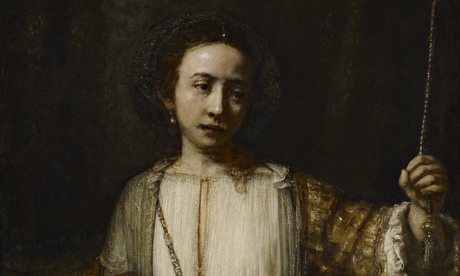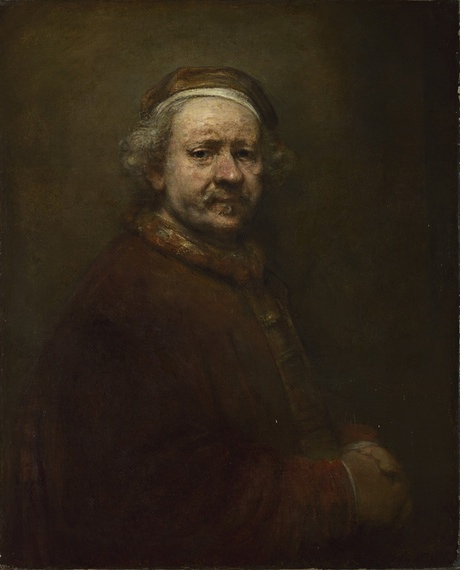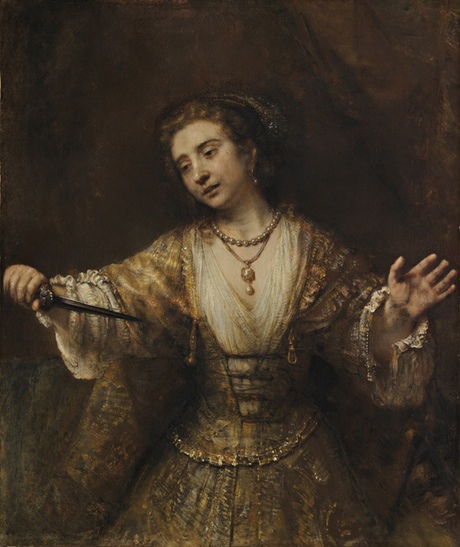Visit ‘Rembrandt: The Late Works’ to learn more about the master’s later life and technique: http://ow.ly/CUcHa
Many of Rembrandt's portraits depict friends, family or professional associates, such as this 'Portrait of Arnout Tholinx', a physician and the brother-in-law of Rembrandt's friend and patron Jan Six.
Some of Rembrandt's finest portraits are on display, including 'Portrait of a Lady with an Ostrich-Feather Fan'. Her accessories are recorded with richly textured strokes, particularly capturing the delicacy of the feathers in the fan.
Visit ‘Rembrandt: The Late Works’ to learn more about the master’s later life and technique: http://ow.ly/CUcHa
Many of Rembrandt's portraits depict friends, family or professional associates, such as this 'Portrait of Arnout Tholinx', a physician and the brother-in-law of Rembrandt's friend and patron Jan Six.
Some of Rembrandt's finest portraits are on display, including 'Portrait of a Lady with an Ostrich-Feather Fan'. Her accessories are recorded with richly textured strokes, particularly capturing the delicacy of the feathers in the fan.
How Rembrandt dressed his women for death
Simon Schama takes a closer look at two studies in sexual tragedy painted in the very last years of the great master's life


Detail from Rembrandt's The Suicide of Lucretia, 1666. Photograph: Minneapolis Institute of Arts. Click to enlarge.
Rembrandt's Eyes was originally published 15 years ago, but the ambition to engage with the artist's life and work went back at least another decade to my earlier book, The Embarrassment of Riches: An Interpretation of Dutch Culture in the Golden Age, when I deliberately shut him out as a misleading Great Exception. By the time I eventually plucked up the courage to tackle the subject, the fashion in Rembrandt studies was beady-eyed disenchantment. The "G" word, as in genius, was dismissed as romantic fetishism; and talk of exceptional originality not explainable by historical or social context was written off as starry-eyed mush. At the same time the Rembrandt Research Project was at its most Jacobin, whittling down a bloated corpus to a scientifically verifiable core: a challenge ultimately defeated by an inability to agree on what the baseline of indisputable Rembrandtism looked like, or indeed how it could ever be fixed in the work of so notoriously shape-shifting an artist. The reclassification of many Rembrandt-effect paintings as works of pupils or assistants had pluralised the artist into a brand, rather than a solitary figure. This pluralisation led to a number of exhibitions whose selling point was to claim – unpersuasively – that but for the obsession of "genius" the pictures of "the workshop" could be valued on a par with those of the master.
Wilfully perhaps, I wanted to go against the grain of this flinty purism, not by restoring breathless enchantment but by giving full weight to the singularity of Rembrandt's achievement in revolutionising so many genres, especially group portraiture; to his reinvention of history painting; to his struggles in finding ways of fitting style to subject (stupendously evident in the great fragment of The Conspiracy of Claudius Civilis); and in the two paintings of Lucretia. Following the poet Jeremias Decker, whose portrait Rembrandt painted and who could find no higher praise for the artist than to praise his mind, I wanted to register the strenuous creativity of his restless intellect, not just the emotive expressiveness. Aside from putting the incommensurability of the master paintings back at the centre of the story I aimed to give intensely detailed readings – the ekphrasis – which once was thought to be the condition of interpretation. There are passages of painting in the late works, now brought together at London's National Gallery, that are so dense in their texture, so thickly woven from spools and spills of brilliant colour that they seemed to call for a descriptive vocabulary not much encouraged by the cool norms or theoretically opaque weight of much modern art historical writing. I was more interested in the loaded brush than the loaded judgment.
Did I over-correct? You decide. But above all go to see the astonishing late paintings, many of them brought to London for the first time, and get a new pair of eyes, courtesy of the master.
❦
In October 1662, when the chill Amsterdam nights were draining light from the afternoons, Rembrandt sold his wife Saskia's grave. The buyer was the gravedigger at the Oude Kerk who made a little money from these transactions, acquiring lots from the hard-pressed and reselling them to those who needed space for the freshly deceased. With the plague raging again in the city, taking more victims than ever before, the market for grave space was brisk and prices high. So men with round-blade shovels came to the place in the chancel behind the organ and turfed out Saskia's bones to make room for the next lodger, one Hillegondt Willems. It was not so very shocking. The fate of mortal remains was of no concern to the church; nor did the site of their repose have any bearing on the salvation of souls, decided alone and from the beginning by the Almighty. One might be buried on a dung heap and still be received into the bosom of the Father.
God knows, Rembrandt needed the money. He lived with just a few sticks of furniture, ate fish and cheese and hard bread and sour beer from plain pewter, and it was still too much. He pawned more, borrowed 537 guilders from Harmen Becker, who lived in grandeur in a stone-faced house on the Keizersgracht and who specialised in making loans to painters in difficulties and getting work from them as security. Rembrandt soon found himself binding over nine paintings (as well as two albums of etchings) to the loan shark, for which he would get nothing but temporary relief on back debts. Hendrickje Stoffels, his lover, managed as best she could. But she had been ground down by their struggles and now her health was failing. The Jordaan, with its houses pressed close against each other and the refuse-clogged alleys between them a cosy home for rats, was a nursery of infection.
 Rembrandt's Self Portrait at the Age of 63, 1669.
Rembrandt's Self Portrait at the Age of 63, 1669.
In 1660 Rembrandt painted Hendrickje, her skin the colour of unrisen dough, dark eyes sunken into puffed-out cheeks. It was time for that perennial ritual in the Rembrandt household, the making of wills. This one needed to be especially careful, since once Hendrickje was gone, her seven-year-old daughter, Cornelia, would, if not otherwise indicated, get a court-appointed guardian who might see to it that Rembrandt had no access to the inheritance. So the will spelled out Hendrickje's wish that Rembrandt be appointed Cornelia's sole guardian; that in the event of Cornelia predeceasing him, his son Titus should be her heir; and that the partnership she had formed with Titus to trade in works of art should, after her death, also be controlled by Rembrandt. The painter would thus "receive the benefits [of Cornelia's legacy] and enjoyment thereof for his nourishment for the rest of his life". When she died in the spring of 1663, one of the 9,000 taken by the bubonic plague that year in Amsterdam, Rembrandt set her in a rented unmarked grave in the Westerkerk. Should the rent fall into arrears or lapse, the grave would be opened again for a new tenant. No one knows how long the body of Hendrickje Stoffels was left undisturbed.
Other women, then, had to model for Rembrandt's two paintings of the suicidal Lucretia, one on the point of thrusting a dagger into her body, the other with the weapon ripped back out, the wound's blood soaking her slit shirt. It is extraordinary that in the very last years of his life Rembrandt should have wanted to paint another study in sexual tragedy. But ever since the Susanna and the Elders of 1634, he had brooded on the relationship between carnal aggression, virtue, and sacrifice; between the rapine stare and the fatal touch; between sex and history. Ten years before, in Bathsheba at Her Bath, he had posed Hendrickje's undressed body in such a way as to provoke both desire and remorse, precoital greed and postcoital shame. Livy's famous history, set in the last days of the early Roman kingdom of the Tarquins, revisited many of those same dark themes that had long obsessed Rembrandt: a wife's innocent loyalty that itself inflamed lust; the malevolent abuse of princely sovereignty; an act of brutal possession that was repaid with political punishment.
Lucretia's husband, Collatinus, was a soldier on campaign for his king, besieging the Ardeans, when he made the mistake of bragging of his wife's superior virtue. To test the boast, he and his companions – among them Sextus Tarquinius, the son of the royal tyrant – rode back to Rome, only to find Lucretia at her spinning wheel, the very emblem of unimpeachable domesticity, while the other wives lounged about in dissipation. Days later, Sextus secretly returned to Lucretia's chamber, attempted to rape her and, when she resisted, threatened to kill both her and his own slave and leave them naked together in her bed. A double sacrifice followed. First Lucretia gives herself to her assailant. The following day she calls her father and husband, confesses her violation, and over their protests, and in their presence, takes a dagger to her heart. Over her corpse, father, husband, and companions (including Marcus Junius Brutus) swear a solemn oath not only to revenge her innocence but to rid Rome forever of the Tarquins. Lucretia's body becomes the altar of republican freedom.
The story, with its richly mingled bloodflow of sex and politics, had long been irresistible to history painters, who had depicted either the act of the rape itself or Lucretia's death in the presence of her friends and family. In both cases, opportunities offered themselves to expose the virtuous body either completely, as in the outrageously voluptuous nude of Giampetro Rizzi, or more conventionally, with a breast or at least a shoulder and the upper chest exposed. But to make us painfully conscious of the prior penetration of her body, Rembrandt has dressed her for death.
The artist has made something crushingly weighty of these costumes, building the paint until it is as solid and impenetrable as the ironclad armour of the heroine's virtue. Yet it is an armour that has been pierced. The deep green impasto of the Washington National Gallery painting is especially worked and layered in the lower part of the painting where Lucretia's skirt is vainly girdled by a belt that circles her body just below the waist. But all this heavy casing of the paint layer is calculated to make the sense of the soft vulnerability of the body within – not just in the painfully delicate exposure of the flesh at her throat and between her breasts, but in the fore-shortened left forearm at her opened sleeve – even more poignant. The fastenings of her bodice have been loosed and hang freely down to her waist. A teardrop pearl, the insignia of her virtue, is suspended just above the site where the dagger will rend the flimsy veil of her shift and into her heart. But her eyes are red with tears already shed, others gathering and brimming; her upper lip moist with misery.
 Lucretia, 1664 by Rembrandt. Photograph: National Gallery
Lucretia, 1664 by Rembrandt. Photograph: National Gallery
In both paintings, Rembrandt, as was his habit, has removed the supporting cast, and with them any distractions that could disperse the concentrated force of the tragedy. But in the Washington painting (as in most past versions of the scene), there is a strongly implied sense of an audience, transferred to the spectator. Lucretia holds up her left hand, both in affirmation of her innocence and also to still the protests of her horrified household. But the Minneapolis version, painted two years later, around 1666, even though representing the subsequent scene where Livy makes the most of the gathered witnesses, effaces them even more completely, picturing Lucretia in the deepest solitude as her lifeblood leaches away. A genteel tradition has imagined that the heroine is holding on to a bell rope, to summon her friends and family. But this supposes her to be the doyenne of some country house in 19th-century Britain where the mistress rings for the servants by pulling on a cord that would ring in the downstairs parlor. Seventeenth-century Amsterdam knew no bell ropes. Lucretia is, in fact, both clinging (for support) and pulling on the cord which will open the concealing curtains of the canopy bed – the bed on which she has twice been violently penetrated, once in rape, once in atonement. She is at the moment of exposure, between private hurt and public grief.
There had never been a Lucretia like this (just as there had never been a Susanna or a Bathsheba like Rembrandt's), her face shiny and pallid with death, a painting of slits and gashes and apertures, where the torn, punctured body of the woman is made utterly naked by being ostensibly covered. The powerless belt slung across her hips in the Washington painting has, in the later work, become a slung sash extending from her right shoulder down to the left side of her waist and so travelling across the sites of her violation. It fixes our gaze, first on the deep V-shaped opening of her shirt and then on the terrible, spreading, soaking bloodstain that extends from her heart down toward her thighs. There is nothing like this bloodstain in all the countless martyrdoms of baroque painting, in all of the spurting severed heads and severed breasts; nothing that pulses quietly and fatally out of an unseen wound. Rembrandt has even made the folds of Lucretia's shift hang forward on either side of the wound, while between them, in a saturated depression, as if rehearsing the site of her rape, the blood-soaked fabric clings wetly to her skin.
Lucretia's stain had long created difficulties for the Christian tradition. The more severe authorities had thought her rape, whatever her personal virtue, a taint from which she could never be cleansed, and judged her suicide, an act abhorrent to God, as compounding rather than expiating the foulness. Calvinism, which placed the utmost emphasis on utter surrender to God's will, deemed self-murder a particularly horrifying defiance of divine dispensation, a complete forfeit of grace.
But then, Rembrandt is no orthodox Calvinist, no orthodox anything. His Lucretia has not taken arms against herself, much less against divine writ. Her pathos is of resignation. She has opened herself, bodily, to the possibility of mercy. Faultless, she has nonetheless sinned; spotless, she has become stained. But she hangs on to the cord, life ebbing from her, awaiting the embrace of compassion, the reception of grace.
• Rembrandt: The Late Works is at the National Gallery, London WC2N, until 18 January. nationalgallery.org.uk. Rembrandt's Eyes is being reissued this month by Penguin. To order a copy for £18.75 (RRP £25), go to bookshop.theguardian.com or call 0330 333 6846.




沒有留言:
張貼留言